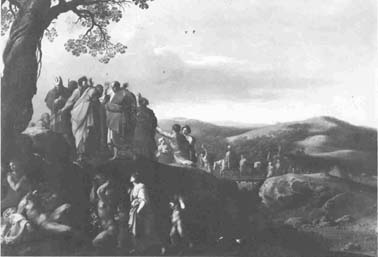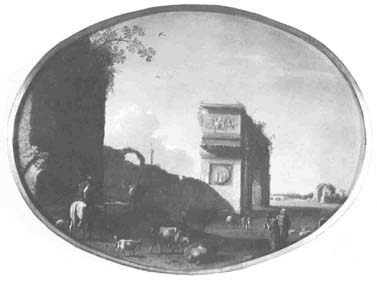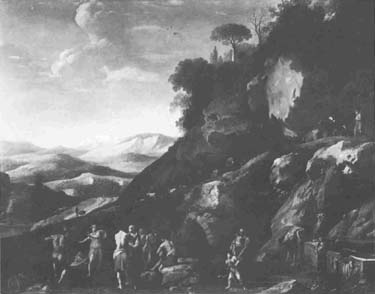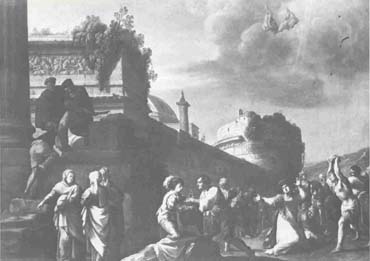
Bulletin 26, 1975
Home
Français
Introduction
History
Annual Index
Author &
Subject
Credits
Contact





A
Poelenburgh in the National Gallery of Canada
by Malcolm Waddingham
Pages 1 | 2
| 3
| 4
A further mark of
Poelenburgh's maturity in this early narrative picture is his
refusal to copy blatantly the style of distinguished Italian artists
such as Annibale Carracci and Caravaggio, and his willingness and
resolve in developing his own northern, independent manner. One can
also admire that, in a country enthusiastic for large and heroic
forms, Poelenburgh portrayed all the drama and strength of a subject
without relinquishing a modest cabinet scale. It must not be
forgotten that Elsheimer, who died in 1610, had left behind
outstanding examples of history and religious subjects on panels of
notably modest dimensions: Poelenburgh admired his method but
remained suitably independent. (11)
The organization of many figures in Clarinda Saving Olinda and
Safrania from the Stake into a convincing design, with bodies
and forms manipulated in various directions, was not without
problems for Poelenburgh, and some of these have survived in pentimenti. (12)
A careful examination of the base below the columns on the
left - in a spot just above the bubbled crown of the bonnet of the
bearded man - reveals a shadowy, overpainted, earlier version of the
head and shoulders of the middle rider of the foreground group.
This suggests that the successful positioning and relationships of
the three cavaliers and their horses required experiment and trial.
In connection with this it is worth noting that the legs of
another horse can just be glimpsed beneath the stomach of the white
horse; they may be supposed to carry the bearded figure behind who
is profiled to the right, though the relation of these equine legs
to rider is not satisfactorily defined. It should also be pointed
out that another strange weakness, or omission, is the
configuration of the legs of the slave with the bundle of branches
who approaches Sofronia from the left: perhaps one is expected to
imagine his left limb completely obscured by the smoke of the fire.
Admittedly, such curiosities are noticeable only after close
observation and they scarcely detract from the excellence of the
final impression.
At this point it may well be asked how one can be sure that
Poelenburgh painted the Olindo and Sofronia and that it was
done in Italy. Familiarity with other works executed by him
naturally helps towards a clear decision but, like the Olindo and
Sofronia, some of these were also once misjudged as Breenberghs.
One notable example is The Martyrdom of Saint Lawrence (fig.
2) in Cassel, which appeared under Breenbergh's name in the 1958
catalogue of the museum. (13) A year later Schaar corrected this
mistake and attributed the panel to Poelenburgh. Stylistically it
certainly fits in well with the few figures and ruins in the
monogrammed, early Landscape with Shepherds in Buckingham
Palace, (14) and also with other later and signed productions. Nor
should The Miraculous Rod of Moses (fig. 3), one of a set of
four copper panels in the Pitti Gallery, be forgotten. (15) The
creator of the muscular Michelangelesque figure lying beneath the
tree is the same artist responsible for the naked and partially
clothed bodies in the Cassel The Martyrdom of Saint Lawrence. And
this same artist created the three stylistically analogous figures
that surround Olindo and Sotronia. The peasant carrying the branches
over one shoulder and under an arm in the Ottawa panel is almost a
twill of the man in the Cassel panel who approaches St Lawrence from
the right corner; both handle timber with the same physical
adroitness and their heads are hidden behind the sticks. Also, the
rider on the far left in The Martyrdom of Saint Lawrence is
mounted on a horse which closely resembles the central, black one in
the foreground of the Ottawa painting.
Before leaving the Cassel picture, it may be worth recalling how the
triumphal arch behind St Lawrence's gridiron recurs, with slight
differences in the low relief decorations, in an oval Roman View
with Cattle (fig.4) in the Pitti Gallery (479). (16) The
archaeological interest in bas-relief carvings is again displayed
in similar representations below one of the Dioscuri in the Olindo
and Sofronia. Moreover, a comparison of many of the figures in
the Ottawa panel with the bucolic dancers and folk in the Uffizi Peasants
Dancing in a Landscape (fig. 5) (17) - and especially with
the shepherd with the bare back - confirms that both are from the
same period. Happily, the panel in Florence is dated 1622, and so
the Olindo and Sofronia must surely have originated at about
the same time.
It is of course dangerous to try to be over-precise in estimating
the exact year of execution. In 1624 Poelenburgh produced the Satyr
and Women Dancing in a Landscape now in Kensington Palace. (18) By
no means a historical or religious piece and very much more a
landscape, the figures in it nonetheless have something in common
with the Olindo and Sofronia. Consequently it may be wiser to
date the Ottawa panel more loosely: 1622-1624 would perhaps be a
safer chronology. Earlier, as the 1620 Ruins in a Landscape in
the Louvre (1084) shows, his depiction of crumbling bricks and
architecture is more picturesque and intense; (19) there is also a
greater emphasis on the way the creeper and bushes emerge verdantly
and richly from the ruins. In the Olindo and Sofronia there
is less excited vibration and a faint hint of intellectuality in
the handling of paint, probably due also to the complex composition.
This could point to some development of maturity after 1620, yet
probably little more than a couple of years or so.
As one thinks of Poelenburgh, memories return of deep pleasure
experienced in front of a small nucleus of paintings, and what
stands out is that most of them were the products of his Italian
period. The sharpest recollections concern works like the Louvre The
Martyrdom of Saint Stephen (fig. 6) where again, as in the Olinda
and Safrania, the architectural features seem to resound with a
drama that subtly reinforces the tragedy of the action. (20) The
triumphal arch, its top corner caught in the sunlight, displays a
violent bas-relief; behind it a cupola, looking distinctly Renaissance
and not unlike a cathedral dome, contributes a note of
contrast, of hope, and of balance. This is the kind of picture,
strong in religious sentiment, to which the Olinda and Sofrania belongs;
not as an inferior member of the group but as one of the most
distinguished.
Apart from its sound artistic character, the value of Clarinda
Saving Olinda and Safrania from the Stake is the information it
provides about Poelenburgh as an ambitious, youthful artist on
Italian soil, and about the way his creativity was challenged and
survived with strength and individuality. It is sad that not all
these qualities endured with the same integrity once he was popular
back home in Utrecht. Yet as one stands before this panel, it should
not be forgotten that quite a number of other seventeenth-century
Dutch artists - Swanevelt, Jan Both, Berchem, Asseleyn, and Dujardin
- went to Italy after Poelenburgh and most of them were indebted in
one way or another to his earlier, pioneering efforts.
Next Page | Notes 1 to 13
1 | 2
| 3
| 4
Annual Index | Author & Subject | Credits | Contact
This digital collection
was produced under contract to Canada's Digital Collections program,
Industry Canada.
"Digital
Collections Program, Copyright
© National Gallery of
Canada 2001"